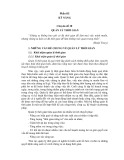
Chapter 13
The Costs of Production
TRUE/FALSE
1. The economic field of industrial organization examines how firms’ decisions about prices and quantities
depend on the market conditions they face.
ANS: T DIF: 2 REF: 13-0 NAT: Analytic
LOC: Costs of production TOP: Industrial organization
MSC: Interpretive
2. Profit equals marginal revenue minus marginal cost.
ANS: F DIF: 1 REF: 13-1 NAT: Analytic
LOC: Costs of production TOP: Profit MSC: Definitional
3. Profit equals total revenue minus total cost.
ANS: T DIF: 1 REF: 13-1 NAT: Analytic
LOC: Costs of production TOP: Profit MSC: Definitional
4. The difference between economic profit and accounting profit is that economic profit is calculated based on
both implicit and explicit costs whereas accounting profit is calculated based on explicit costs only.
ANS: T DIF: 2 REF: 13-1 NAT: Analytic
LOC: Costs of production TOP: Economic profit | Accounting profit
MSC: Interpretive
5. Accounting profit is greater than or equal to economic profit.
ANS: T DIF: 2 REF: 13-1 NAT: Analytic
LOC: Costs of production TOP: Accounting profit | Economic profit
MSC: Analytical
6. Economic profit is greater than or equal to accounting profit.
ANS: F DIF: 2 REF: 13-1 NAT: Analytic
LOC: Costs of production TOP: Accounting profit | Economic profit
MSC: Analytical
7. Although economists and accountants treat many costs differently, they both treat the cost of capital the same.
ANS: F DIF: 2 REF: 13-1 NAT: Analytic
LOC: Costs of production TOP: Economic profit | Accounting profit
MSC: Interpretive
8. Accountants keep track of the money that flows into and out of firms.
ANS: T DIF: 1 REF: 13-1 NAT: Analytic
LOC: Costs of production TOP: Accounting profit
MSC: Interpretive
9. When economists speak of a firm's costs, they are usually excluding the opportunity costs.
ANS: F DIF: 2 REF: 13-1 NAT: Analytic
LOC: Costs of production TOP: Opportunity costs
MSC: Interpretive
10. Economists and accountants both include forgone income as a cost to a small business owner.
ANS: F DIF: 2 REF: 13-1 NAT: Analytic
LOC: Costs of production TOP: Opportunity costs
MSC: Interpretive
82

83 Chapter 13/The Costs of Production
11. Economists and accountants usually disagree on the inclusion of implicit costs into the cost analysis of a firm.
ANS: T DIF: 1 REF: 13-1 NAT: Analytic
LOC: Costs of production TOP: Implicit costs
MSC: Interpretive
12. Implicit costs are costs that do not require an outlay of money by the firm.
ANS: T DIF: 1 REF: 13-1 NAT: Analytic
LOC: Costs of production TOP: Implicit costs
MSC: Definitional
13. Accountants often ignore implicit costs.
ANS: T DIF: 1 REF: 13-1 NAT: Analytic
LOC: Costs of production TOP: Implicit costs
MSC: Interpretive
14. In the long run, a factory is usually considered a fixed input.
ANS: F DIF: 2 REF: 13-2 NAT: Analytic
LOC: Costs of production TOP: Long run MSC: Interpretive
15. Diminishing marginal productivity implies decreasing total product.
ANS: F DIF: 2 REF: 13-2 NAT: Analytic
LOC: Costs of production TOP: Diminishing marginal product
MSC: Interpretive
16. Diminishing marginal product exists when the total cost curve becomes flatter as outputs increases.
ANS: F DIF: 2 REF: 13-2 NAT: Analytic
LOC: Costs of production TOP: Diminishing marginal product
MSC: Interpretive
17. Diminishing marginal product exists when the production function becomes flatter as inputs increase.
ANS: T DIF: 2 REF: 13-2 NAT: Analytic
LOC: Costs of production TOP: Diminishing marginal product
MSC: Interpretive
18. A second or third worker may have a higher marginal product than the first worker in certain circumstances.
ANS: T DIF: 2 REF: 13-2 NAT: Analytic
LOC: Costs of production TOP: Marginal product
MSC: Interpretive
19. The typical total-cost curve is U-shaped.
ANS: F DIF: 2 REF: 13-2 NAT: Analytic
LOC: Costs of production TOP: Total-cost curve
MSC: Interpretive
20. The average fixed cost curve is constant.
ANS: F DIF: 2 REF: 13-2 NAT: Analytic
LOC: Costs of production TOP: Average fixed cost
MSC: Interpretive
21. In the short run, if a firm produces nothing, total costs are zero.
ANS: F DIF: 2 REF: 13-2 NAT: Analytic
LOC: Costs of production TOP: Total costs | Fixed costs
MSC: Interpretive
22. If a firm produces nothing, it still incurs its fixed costs.
ANS: T DIF: 2 REF: 13-2 NAT: Analytic
LOC: Costs of production TOP: Fixed costs MSC: Interpretive

Chapter 13/The Costs of Production 84
23. The shape of the total cost curve is unrelated to the shape of the production function.
ANS: F DIF: 2 REF: 13-2 NAT: Analytic
LOC: Costs of production TOP: Total-cost curve | Production function
MSC: Interpretive
24. The shape of the total cost curve is related to the shape of the production function.
ANS: T DIF: 2 REF: 13-2 NAT: Analytic
LOC: Costs of production TOP: Total-cost curve | Production function
MSC: Interpretive
25. If the marginal cost of producing the tenth unit of output is $3, and if the average total cost of producing the
tenth unit of output is $2, then at ten units of output, average total cost is rising.
ANS: T DIF: 3 REF: 13-3 NAT: Analytic
LOC: Costs of production TOP: Marginal cost | Average total cost
MSC: Analytical
26. If the marginal cost of producing the tenth unit of output is $2.50, and if the average total cost of producing
the tenth unit of output is $3, then at ten units of output, average total cost is rising.
ANS: F DIF: 3 REF: 13-3 NAT: Analytic
LOC: Costs of production TOP: Marginal cost | Average total cost
MSC: Analytical
27. If the marginal cost of producing the fifth unit of output is higher than the marginal cost of producing the
fourth unit of output, then at five units of output, average total cost must be rising.
ANS: F DIF: 3 REF: 13-3 NAT: Analytic
LOC: Costs of production TOP: Marginal cost | Average total cost
MSC: Analytical
28. Marginal costs are costs that do not vary with the quantity of output produced.
ANS: F DIF: 1 REF: 13-3 NAT: Analytic
LOC: Costs of production TOP: Marginal cost
MSC: Definitional
29. Several related measures of cost can be derived from a firm's total cost.
ANS: T DIF: 2 REF: 13-3 NAT: Analytic
LOC: Costs of production TOP: Cost curves MSC: Interpretive
30. Variable costs usually change as the firm alters the quantity of output produced.
ANS: T DIF: 2 REF: 13-3 NAT: Analytic
LOC: Costs of production TOP: Variable costs
MSC: Definitional
31. Variable costs equal fixed costs when nothing is produced.
ANS: F DIF: 2 REF: 13-3 NAT: Analytic
LOC: Costs of production TOP: Variable costs
MSC: Interpretive
32. The cost of producing an additional unit of a good is not the same as the average cost of the good.
ANS: T DIF: 2 REF: 13-3 NAT: Analytic
LOC: Costs of production TOP: Average total cost
MSC: Interpretive
33. Average variable cost is equal to total variable cost divided by quantity of output.
ANS: T DIF: 2 REF: 13-3 NAT: Analytic
LOC: Costs of production TOP: Average variable cost
MSC: Definitional

85 Chapter 13/The Costs of Production
34. The average total cost curve is unaffected by diminishing marginal product.
ANS: F DIF: 3 REF: 13-3 NAT: Analytic
LOC: Costs of production TOP: Diminishing marginal product | Average total cost
MSC: Interpretive
35. The average total cost curve reflects the shape of both the average fixed cost and average variable cost curves.
ANS: T DIF: 2 REF: 13-3 NAT: Analytic
LOC: Costs of production TOP: Average total cost
MSC: Interpretive
36. If the marginal cost curve is rising, then so is the average total cost curve.
ANS: F DIF: 2 REF: 13-3 NAT: Analytic
LOC: Costs of production TOP: Marginal cost | Average total cost
MSC: Interpretive
37. The marginal cost curve intersects the average total cost curve at the minimum point of the average total cost
curve.
ANS: T DIF: 2 REF: 13-3 NAT: Analytic
LOC: Costs of production TOP: Average total cost | Marginal cost
MSC: Interpretive
38. The marginal cost curve intersects the average total cost curve at the minimum point of the marginal cost
curve.
ANS: F DIF: 2 REF: 13-3 NAT: Analytic
LOC: Costs of production TOP: Average total cost | Marginal cost
MSC: Interpretive
39. Assume Jack received all A's in his classes last semester. If Jack gets all B's in his classes this semester, his
GPA may or may not fall.
ANS: T DIF: 3 REF: 13-3 NAT: Analytic
LOC: Costs of production TOP: Average total cost
MSC: Interpretive
40. Average total cost and marginal cost express information that is already contained in a firm's total cost.
ANS: T DIF: 2 REF: 13-3 NAT: Analytic
LOC: Costs of production TOP: Average total cost
MSC: Interpretive
41. Average total cost reveals how much total cost will change as the firm alters its level of production.
ANS: F DIF: 2 REF: 13-3 NAT: Analytic
LOC: Costs of production TOP: Average total cost
MSC: Interpretive
42. The shape of the marginal cost curve tells a producer something about the marginal product of her workers.
ANS: T DIF: 2 REF: 13-3 NAT: Analytic
LOC: Costs of production TOP: Marginal cost | Marginal product
MSC: Interpretive
43. When average total cost rises if a producer either increases or decreases production, then the firm is said to be
operating at efficient scale.
ANS: T DIF: 2 REF: 13-3 NAT: Analytic
LOC: Costs of production TOP: Efficient scale
MSC: Interpretive
44. Fixed costs are those costs that remain fixed no matter how long the time horizon is.
ANS: F DIF: 2 REF: 13-4 NAT: Analytic
LOC: Costs of production TOP: Fixed costs MSC: Interpretive

Chapter 13/The Costs of Production 86
45. Diseconomies of scale often arise because higher production levels allow specialization among workers.
ANS: F DIF: 2 REF: 13-4 NAT: Analytic
LOC: Costs of production TOP: Diseconomies of scale
MSC: Interpretive
46. Economies of scale often arise because higher production levels allow specialization among workers.
ANS: T DIF: 2 REF: 13-4 NAT: Analytic
LOC: Costs of production TOP: Economies of scale
MSC: Interpretive
47. If long-run average total cost is rising, then the firm is experiencing economies of scale.
ANS: F DIF: 2 REF: 13-4 NAT: Analytic
LOC: Costs of production TOP: Economies of scale | Diseconomies of scale
MSC: Definitional
48. The fact that many inputs are fixed in the short run but variable in the long run has little impact on the firm's
cost curves.
ANS: F DIF: 2 REF: 13-4 NAT: Analytic
LOC: Costs of production TOP: Long run MSC: Interpretive
49. In some cases, specialization allows larger factories to produce goods at a lower average cost than smaller
factories.
ANS: T DIF: 2 REF: 13-4 NAT: Analytic
LOC: Costs of production TOP: Specialization
MSC: Interpretive
50. The use of specialization to achieve economies of scale is one reason modern societies are as prosperous as
they are.
ANS: T DIF: 2 REF: 13-4 NAT: Analytic
LOC: Costs of production TOP: Specialization
MSC: Interpretive
51. As a firm moves along its long-run average cost curve, it is adjusting the size of its factory to the quantity of
production.
ANS: T DIF: 2 REF: 13-4 NAT: Analytic
LOC: Costs of production TOP: Average total cost
MSC: Interpretive
52. Because of the greater flexibility that firms have in the long run, all short-run cost curves lie on or above the
long-run curve.
ANS: T DIF: 2 REF: 13-4 NAT: Analytic
LOC: Costs of production TOP: Average total cost
MSC: Interpretive
53. There is general agreement among economists that the long-run time period exceeds one year.
ANS: F DIF: 2 REF: 13-4 NAT: Analytic
LOC: Costs of production TOP: Long run MSC: Interpretive



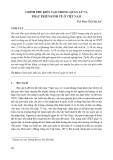
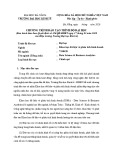
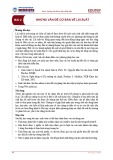
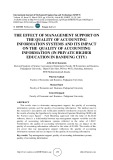
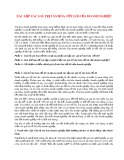
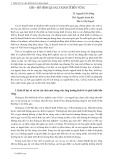
![Giáo trình Nền kinh tế công cộng [mới nhất]](https://cdn.tailieu.vn/images/document/thumbnail/2018/20180531/hpnguyen13/135x160/4911527762697.jpg)
